We rolled into the little mountain town of Cocuy at six-thirty in the morning after jouncing around in our bus seats all night from Tunja. We inquired at the first hotel we saw, a bit of a flophouse, booked a cheap room and flopped. We got up around noon and went looking for information. We knew little about Parque Nacional El Cocuy except that it was supposed to be beautiful and cold. In Bogotá we had stopped by the national parks office. They had no useful maps and little first hand information. One woman emailed me some trail descriptions in Spanish that I foolishly translated into English using Google Translator before printing them out. Now I know why menus in South America often translate things like trucha a la pimienta as trout to the pepper or a piña colada as a fragmentation hand grenade. My printout includes instructions such as, "After a promotion brunette arrives at La Silla from where it ascends to reach the glacier slabs." Not the kind of thing you want to find yourself reading when you get lost in the fog.
There was little information to be had. Both the tourist information booth and the national parks office were closed. We walked around the town a bit and through the little cemetery on the edge of town. We checked in at the parks office a couple more times before finally meeting Fabio, the young ranger presiding, around four. He gave us a topographical map, unfortunately about the size of a postcard. He had no other map to sell us. He also gave us very little useful information and told us that for the most interesting treks we had to hire a guide. I am used to being treated like a tenderfoot dude by rangers in the U.S. who can't tell you anything about a trail that they haven't seen from the window of their pickup trucks, but I was disappointed in Fabio. He seemed to be made of better stuff and besides, in the U.S. I can usually get decent information and good maps through other sources.
Finally we met a shopkeeper named Beto who sold us a map that was more conceptual than useful, but he brought us out to the square and showed us the route we could take on a giant concrete relief map of the Sierra Nevada complete with lake and river systems of running water. He assured us that we could do it without a guide and when I had seen the layout I thought so too.



The next morning we caught a ride in the Lechero, a truck that goes around to the local mountain farms collecting milk. It left us at a crossroads in the fog. We hiked into the park as the mist lifted a bit, heading through a long valley (and past, according to my translation, "the CEPAM, Experimental Center of the High Mountain Pilot Guinea" ). After passing some lakes we started toward a pass of 4,400 meters (about 14,500 ft, the same height as Mount Whitney). The landscape was magical ("begins an arduous climb, for super moor moor on brown soils around the south side of Bells peaks"). Peaks started to reveal themselves here and there as we climbed. For a majority of our trek we saw little through the near constant mist or rain. But now and then things would clear a bit and it had the effect of a magician slowly pulling a scarf off some wondrous object. Excitement would grip us and we would stop, staring slack-jawed. The landscape when revealed was as breathtaking as Torres del Paine, only we were all alone. Sometimes, especially in the evening, the magician would pull the scarf completely away and all would be revealed. Inevitably the mist would return, but by then the granite towers and sculptures were in our minds and their magic persisted though we could not see them.







The majority of Parque Nacional El Cocuy is páramo. Páramo is a stange and rare ecosystem. It occurs only in high mountainous regions of the tropics. Most of the páramo that exists in the world is in Colombia. It looks strangely desertlike. I say strangely because the rain is almost constant and it is very cold. It is dominated by a large plant that looks like a cactus only it has soft furry leaves that feel like puppy ears and cartoonishly fuzzy yellow flowers. They are a type of rosette called espeletia. The páramo has several other plants that I have never seen before as well as more common flowers such as lupine and Indian paintbrush.





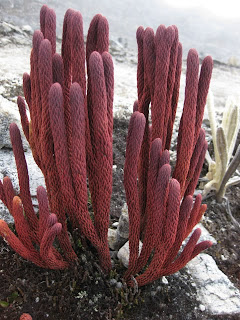

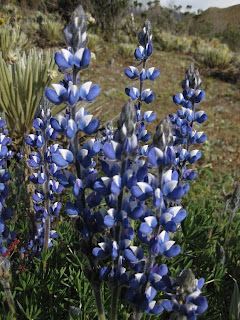

That first day we crossed the pass and got some good views as the clouds cleared. We hiked down from the pass and camped by a river surrounded by espeletia. The rain held off until I started cooking dinner at which point it poured. Thank God we have good gear. When I finished cooking, I dried off and got into dry clothes and we ate in the cozy confines of our tent. I want to take this opportunity to thank my parents for bringing me my raincoat, Claudia Anderson for giving me a pair of Speedo gloves, which as their name suggests are excellent when wet, and Mike Grafton for giving me his gaiters. All were greatly appreciated in the páramo.
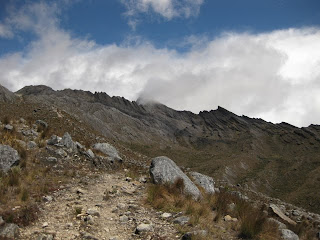


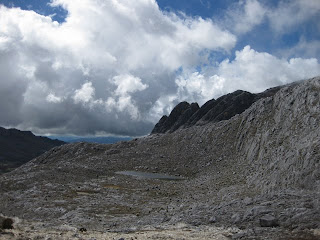

The following day we crossed another pass following cairns ("guided by pillars or stone men"), with occasional partial clearing and views of the imposing peaks around us, and down to the beautiful Laguna de la Plaza. We got there quite early and decided to push on for the other side of the lake to shorten our hike the following day. Up until then our trail had been amazingly easy to follow, even in the fog. It was well marked and clear. It even had switchbacks in the steep parts. I was scoffing at Fabio. It was the easiest trail we had seen in South America. Well, things got more difficult around the lake. The side of the lake was steep and consisted of molded slabs of granite that were insanely slippery when wet. These slabs were broken up by huge chasms and there was such a profusion of cairns that it became quite difficult, especially in the low mist.
Finally it was getting late and we found a flat sandy spot high above the lake to camp. The sky cleared completely and we were in heaven as we ate dinner. It had been so long since we had been trekking, we had almost forgotten how special it was. Our legs were holding up well and our bodies felt great from the exercise. As the sun set, it became bitterly cold and as we settled into our sleeping bags at 6:30 pm I thought, "If it rains tonight it will be snow."

















We heard the rain hitting our tent during the night, but in the morning we heard nothing and thought it had stopped until Hilary touched the side of the tent sending a large clump of snow tumbling to the ground. The sound of snow hitting the tent resumed. She opened her door and a look of horror came over her face and she gave me the "we are doomed" look. I felt a little more sanguine about it. As a kid my scout master, Maurry Tamarkin, had a special fondness for taking us camping in blizzard conditions so I had seen this before. Still, it was a little nervewracking. The only consistent information we had gotten was that it wouldn't snow below the peaks. We didn't really have the proper gear for hiking in the snow. It was still coming down steadily. I was pretty sure that once the warmth of day arrived it would turn to rain and melt off some of the snow, but... We decided to give it until nine before we made a decision about what to do. As you might have guessed from the beginning of this post, I have been dipping into the Bible a bit (we have a small Gideons New Testament--King James version). It is wonderful reading and I have discovered a great fondness for John the Baptist, but if you are ever camping out in the wilderness with snow coming down like the dickens, verily verily I say unto you don't go to the Gospel of John (unrelated, I believe) to calm you. It is some heavy stuff, even for an agnostic.





Luckily the snow did turn to rain and the granite quickly cleared of snow. Unfortunately the snow started melting so fast that a river formed outside our tent, threatening to turn our flat sandy area into a small pond. We got packed up quickly and decided to head back. As much as we wanted to finish the route, and I am sure in retrospect we could have, we weren't prepared for snow, and we were just happy to be back to trekking again. If anything happened out there, there weren't going to be any construction workers building an aqueduct to bail us out.
We set out as the mist descended to all time lows. Picking our way over the slick granite, it took us several hours to get back to the head of the lake. After we set up camp we were treated to another late afternoon and evening of splendid weather.




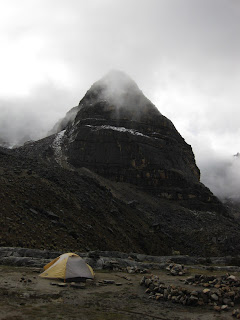








The next day we returned over the passes to the valley near the entrance of the park. It started raining while I was making breakfast and rarely let up. By the time we were eating lunch and our cheese and salami were getting soaked I started to curse the heavens. There is something very personal about getting poured on and I was starting to take offence. Everything was soaked and my mood had taken on the sodden unpleasantness of the weather. Luckily when we got to the campsite we were treated to the warmest and driest afternoon of the trip. We scattered all our things about to dry and my mood soared.

On our final day we hiked out of the park and down through the farmland below, enjoying the animals and flowers and the comparatively dry weather. After walking most of the day and seeing almost no vehicles, we jumped into a passing potato truck with a local named Mario for the last couple miles to Cocuy. Mario invited us to his house, but we were too tired. We went to bed early and caught a bus at 4am to Pamplona.
When I close my eyes I can still see the mist clearing and those amazing peaks appearing like a cry from the wilderness. Hilary has promised that by the time I turn 50 we will come back and do the whole trek. Maybe next time we will come in the dry season.

















4 comments:
I love the cairns! And the mist. The snow on those Dr. Suess plants is beautiful. You're making me miss our tent...
Your pics are gorgeous! It must have been an amazing experience to wake up to all that snow. It looks so peaceful.
Hello,
I'm so glad to read your blog about El Cocuy; it's probably the most recent entry I've found on the Web.
Can you please email me at cia@ext212.com because I have several questions about the park. I am going there in December and would really like to do it without a guide to save money. (They are charging $500 per person now!)
My partner and I have done the Argentina side of Patagonia and the Spanish side of the Pyrenees without guides and I think with a map and a well-marked trail, we would be fine.
Your help would be greatly appreciated.
Cia
I'm amazed you guys are still traveling -what a fantastic journey. Betsy and I miss you both and can't wait to see you.
Post a Comment